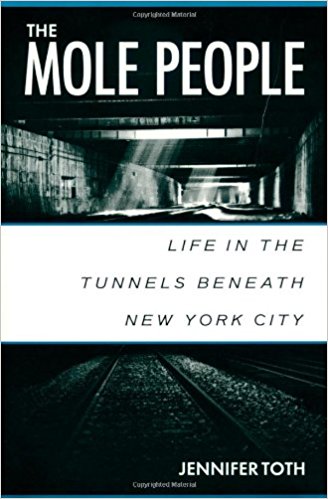
I recently read a novel called Reliquary by Douglas Preston and Lincoln Child. It is book number 2 in their Agent Pendergast series, and I highly recommend it. I have always enjoyed good mysteries and these books combine mystery with myth, science, and a little fantasy. The first book, Relic, investigates the bloody murders that have been taking place at the New York Museum of Natural History—all evidence points to a non-human creature living in the basement. And everything may be linked to an exploration of an ancient people in South America back in the 1980’s! The second book investigates more murders occurring on the streets of New York City—is it possible the same thing is happening as it was in the Museum?

I give you this little two sentence summary in order to avoid spoiling the story, but also to show you how I came upon the non-fiction book The Mole People by Jennifer Toth. I have read several other fantasy stories that have referred to people living in underground New York, but Reliquary is the first one I have seen that appears well researched. The authors state in the Afterword that the majority of their depiction of the homeless living in the tunnels of New York is based on Jennifer Toth’s research.
Jennifer Toth is a journalist who spent some time in the early 90’s interviewing the homeless of New York, namely those known as Mole People—those living underground, mainly the subway tunnels and other abandoned areas below the surface. For many years, authorities refused to publicly acknowledge the vast homeless population inhabiting the tunnels of New York. To admit the extent of humanity making their homes underground would not only shock the population at large, but make the local police and other authorities look like they have no control. Toth decided to find the truth for herself, often by risking her own life and safety in order to talk to the communities living underneath the city.
No one knows exactly how vast the New York underground is. Toth writes, “New York’s subway lines wind through 731 sprawling miles of New York’s five boroughs, in tunnels that burrow down to eighteen stories below ground at 191st Street and Broadway in Manhattan. These miles are divided among 23 lines and 466 stations. New York’s subways constitute the largest urban railroad system in the world.” And that is only the active subway lines. This does not include abandoned tunnels, old lines, random structures built whose records were never found, water mains, cable lines, more construction… it’s a real world labyrinth.

Too often the homeless find their way to these depths. The underground is warmer than ‘topside’, police rarely venture down; it’s an easy place to hide, use drugs, drink, hide children from foster care, murder, etc. What most people do not know, is that there are thousands of people who have chosen to live this hidden life. Many of them have built their own communities, some are loners, some are followers, and others are leaders. It’s a whole other world unto itself.
Toth does a brilliant job of bringing these forgotten people’s lives into the light. Yes, many have mental health issues, but many do not—and all of them have a story. All of these human beings have a mother and a father, and a place they came from—some more difficult than others. It is too easy for us living ‘up top’ to overlook those hidden in the shadows or the ones trying to make a bed in the same place people catch a train to work.
Toth explores and learns from communities made up of single people, couples, families with children, and teenagers just trying to make it to the next day. She says, “Very early on, I recognized that they gave me more than I could give them. They showed me warmth in their cold, often mean world, which gave me hope, not only for them, but for all things…Most of all, they showed me that, even in the worst conditions, people can care for each other over themselves.”
What this book taught me is that every person matters. Every person wants to share their story. Even if they flee to the hidden tunnels of New York City, they do not want to be forgotten. I admire Toth for opening herself up to these people—showing them the respect they deserve as human’s with dignity and sharing their stories with the world. I do not think I could have done the same. The filth, disease, and danger one is exposed to down in the tunnels are too great a risk. In my opinion, Toth showed the face of Christ to these people, by acknowledging them as human persons. They became not just ‘mole people’ to her, but people with an identity.
There is some controversy surrounding Toth’s book in that it is difficult to corroborate all of her stories—several of the people she interviewed disappeared or died. But as I read it, it rang with the truth. The stories she tells are too bizarre and too human for anyone to imagine. The interviews themselves are filled with such human sorrow and suffering, that they must be real. But most are also filled with joy and a desire for life. As they say, truth is stranger than fiction. I have not seen what she has seen, but I believe that what she saw and heard are true and she was meant to bring the Mole People’s truth to the surface.






Leave a Reply